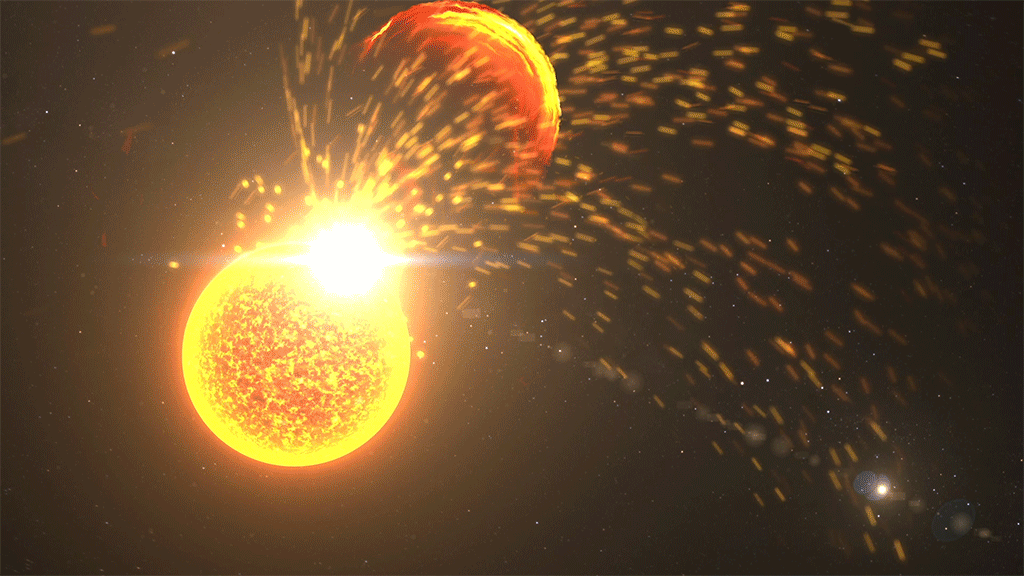Solar 'superflares' millions of times stronger than anything today may have sparked life on Earth
Intense solar storms may have delivered Earth its earliest building blocks of life, new research suggests.

Life on Earth could have been sparked by enormous superflares from a hyperactive young sun, a new study suggests.
By firing charged particles found in the solar wind at a concoction of gases present in Earth's early atmosphere, scientists found that the combined ingredients form significant quantities of amino acids and carboxylic acids — the building blocks for proteins and all organic life.
Scientists have been puzzling over the conditions that sparked life on Earth since the 1800s, when it was speculated that life may have begun in a primordial chemical soup referred to as a "warm little pond." In the 1950s, experiments that exposed gas mixtures of methane, ammonia, water, and molecular hydrogen to artificial lightning showed that 20 different amino acids formed from the process.
In the years since, however, the picture has been complicated. Scientists found that Earth's early atmosphere was filled with less ammonia and methane than previously thought, and more carbon dioxide and molecular nitrogen — both of which are gases that take a lot more energy to break down than lightning alone could provide.
Now, a new study, published April 28 in the journal Life, has used a particle accelerator to find that cosmic rays from fiercely energetic superflares could have provided the necessary jump-start for life on Earth.
"Most investigators ignore galactic cosmic rays because they require specialized equipment, like particle accelerators," lead study author Kensei Kobayashi, a professor of chemistry at Yokohama National University in Japan, said in a statement. "I was fortunate enough to have access to several of them near our facilities."
Get the world’s most fascinating discoveries delivered straight to your inbox.
Stars generate powerful magnetic fields, created through the flow of electrical charges in the molten plasma that runs along and beneath their surfaces. On occasion, these magnetic field lines knot into kinks before suddenly snapping, releasing energy in bursts of radiation called solar flares and explosive jets of solar material called coronal mass ejections (CMEs).
When this solar material — primarily consisting of electrons, protons and alpha particles — smashes into Earth's magnetic field, it triggers a geomagnetic storm, agitating molecules in our atmosphere to create colorful auroras known as the northern lights. The largest solar storm in recent history was the 1859 Carrington Event, which released roughly as much energy as 10 billion 1-megaton atomic bombs, but even this event is dwarfed by the power of a superflare, which could be anywhere from hundreds to thousands of times more energetic.
Superflares of this kind typically only erupt once every 100 years or so, but that may not have always been the case. By looking at data from NASA's Kepler mission, which between 2009 and 2018 collected information on Earth-like planets and their stars, a 2016 study in the journal Nature Geoscience showed that, during Earth's first 100 million years the sun was 30% dimmer, yet superflares burst from its surface every three to 10 days.
To see the role superflares could have played in creating amino acids on ancient Earth, the researchers of the new study combined carbon dioxide, molecular nitrogen, water and a varying amount of methane into mixtures of gases they could expect to find in our early atmosphere. Then, by either shooting the gas mixtures with protons from a small particle accelerator (known as a tandem accelerator) or igniting them with simulated lightning, the scientists sparked the production of amino acids and carboxylic acids — both important chemical prerequisites for life.
As the researchers increased the methane levels, the amino acids and carboxylic acids spawned by both the protons and the lightning strikes grew, but to generate them at detectable levels the proton mixture only needed 0.5% methane concentration, whereas the lightning discharges needed 15%.
"And even at 15% methane, the production rate of the amino acids by lightning is a million times less than by protons," said study co-author Vladimir Airapetian, an astrophysicist at NASA’s Goddard Space Flight Center, who also worked on the 2016 Nature Geosciences study. "During cold conditions you never have lightning, and early Earth was under a pretty faint sun. That's not saying that it couldn't have come from lightning, but lightning seems less likely now, and solar particles seem more likely."

Ben Turner is a U.K. based writer and editor at Live Science. He covers physics and astronomy, tech and climate change. He graduated from University College London with a degree in particle physics before training as a journalist. When he's not writing, Ben enjoys reading literature, playing the guitar and embarrassing himself with chess.



